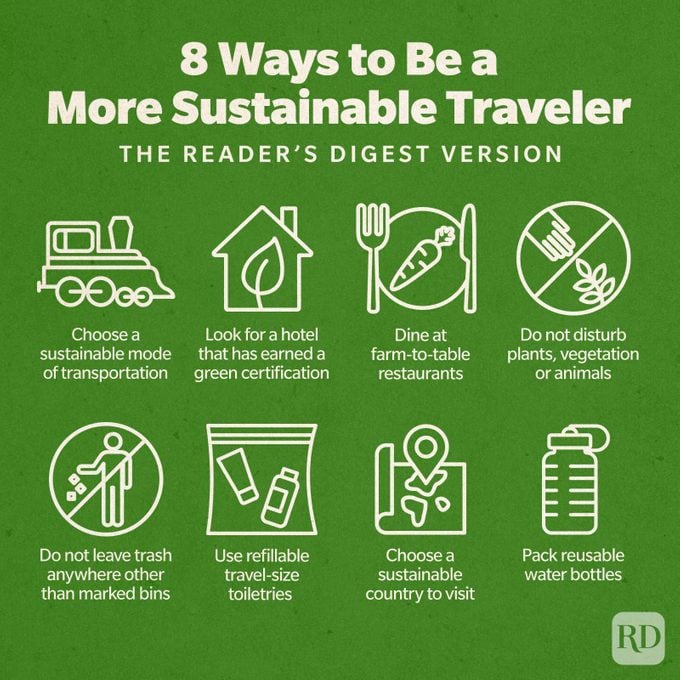8 Ways to Be a More Sustainable Traveler
Updated: Mar. 09, 2023

Here's how to make your next vacation a positive experience for you—and the planet.
Because it’s responsible for so many once-in-a-lifetime experiences and memories, there’s no question that travel has a lasting impact on all of us. What experts are now starting to understand more clearly, though, is the lasting impact it also has on the environment and the people who actually live in a destination. Just look at Venice, Italy. It’s sinking, and locals are moving out in droves because overtourism is depleting natural resources and making the city too crowded for anyone to live comfortably. That’s just one example of a growing problem and the reason sustainable travel is so vital.
“Sustainable travel is more important than ever as we rebound from the pandemic and look for new ways to combat climate change and mitigate its effects around the world,” says Lindsey Ueberroth, CEO of Beyond Green, a global collection of hotels dedicated to sustainability. “When we recognize that our travel choices matter, we become more empowered to help protect the environment, support conservation, honor local traditions, and contribute to socioeconomic opportunities for local communities through our explorations.”
We’re going to show you how you can make a difference by traveling sustainably, from where you go to how you get there to where you stay. Sustainable travel is an easy way to help save the planet, and it won’t cost you more either. You can travel sustainably within any budget, and the memories you make will be priceless.
What is sustainable travel?
Simply put, sustainable travel means increasing the benefits and decreasing the negative impact of tourism on a destination.
“It is all about recognizing the responsibility we have when exploring the world, and making decisions that maximize our positive impact on the places we visit and people we meet along the way,” explains Ueberroth.
Why is sustainable travel important?
As we’ve seen time and time again, travel and tourism can have both positive and negative effects on local residents, communities, and the environment.
Environmental impact
We’ve seen the damage tourists have done, both unintentionally and intentionally, to the coral reefs, the National Parks, and historic landmarks. Follow the saying, “Take only memories, leave only footprints.” Don’t take home natural resources like sand or shells, and don’t leave behind trash. “From an environmental standpoint, making more sustainable travel choices is not only the right (and arguably only) thing to do at this critical moment in our planet’s history, but it can be more cost-efficient too,” says Ueberroth. For example, carrying reusable items like water bottles cuts down on trash as well as personal expenses.
Economic impact
Tourism has the power to revitalize communities when travelers choose to support locally owned hotels and restaurants rather than chains. Instead of buying generic souvenirs made in China (that have to be shipped to the area), buy something handmade by a local artist. The more money that can be put directly back into local hands, the better it is for the whole community.
Social impact
Social impact refers to the ways tourism affects the people who live in a destination. It can empower them and encourage them to feel proud, or it can actually destroy a culture by making its members ashamed of their heritage or their “old” ways. Although it should go without saying, travelers should always respect different cultures, treat all people as equals, and recognize their customs as simply a different lifestyle rather than as a tourist attraction. The beauty of travel is getting to meet people who live totally different lives than you and realizing that, in the most fundamental ways, we are all the same. Many travel companies now offer social impact trips that give you the opportunity to directly help a community in a specific way, whether you’re walking with shepherds in the Himalayas, volunteering with elephants, or participating in wildlife conservation projects.
What are the benefits of sustainable travel?
“Sustainable travel is not about giving something up,” assures Ueberroth. “It’s about gaining something more.” We know sustainable travel can offset the negative social, economic, and environmental impacts noted above, but it also offers unexpected pleasures to travelers themselves.
According to Ueberroth, “Traveling sustainably is not only altruistic but also provides real and meaningful benefits to us as travelers. For example, when we decide to support local businesses—whether staying at a cozy family-run guest house, eating at a neighborhood restaurant serving regional fare, or buying handmade products directly from artisans—we also connect with people from other cultures and gain insight into other ways of life, which is one of the most powerful and transformative gifts that travel offers. In the long run, these experiences stay with us far longer than a week spent by the pool, and they can also leave positive ripple effects behind—making it a true win-win. Traveling in this way is both something we can feel good about, and often leads to meeting other like-minded people who share similar values and spirit of adventure.”
How to travel more sustainably

Because your carbon footprint—the amount of carbon dioxide released into the atmosphere as a result of any action—gets higher the further away you travel, a road trip close to home will always be best for the earth. In fact, you should always try to eat and shop locally.
But you don’t want to stay home all the time, so how can you make the positive impact of travel outweigh any negative?
Pick a more sustainable location
Here are half a dozen destinations celebrated for sustainable travel:
- Sweden. The greenest country in the world, according to Sustainability magazine, Sweden has the highest renewable energy usage and the lowest carbon emissions. It also has food banks, recycling systems, gender equality, excellent education, and housing for vulnerable people, all credited with contributing to its sustainability.
- Costa Rica. One of the leaders of the sustainable travel movement, Costa Rica uses almost 100 percent renewable energy and has led the way in tackling deforestation. Small but mighty, the country is home to 5 percent of the world’s land-based biodiversity and 3.5 percent of its marine life, and has protected 25 percent of its entire territory through the National System of Conservation Areas.
- Bhutan. The first carbon negative country, Bhutan may be able to attribute its success to the fact that it uses the Gross National Happiness Index to measure development rather than the standard Gross Domestic Product Index. This holistic approach is all about improving its citizens’ happiness and well-being environmentally and socio-culturally, not just economically.
- Finland. With more than 75 percent of its country made up of forest—most of it protected—Finland has the world’s cleanest air, according to the World Health Organization. Cleaner air results in cleaner food, which results in healthier citizens. No wonder Finland has been named the happiest country in the world five years in a row.
- Slovenia. The first country to be declared a Green Destination of the World, Slovenia has one of the highest rates of protected land in the world. Covered in natural greenery itself, it awards its own SLOVENIA GREEN LABEL to local accommodations, cuisine, attractions, and more that meet its high sustainability standards.
- Alaska. If you want to stay closer to home and support U.S. tourism, Alaska is the state to visit. Filled with untouched natural beauty and home to more than 100 national and state parks, it’s no wonder it’s called The Last Frontier. For the most eco-friendly vacation, support companies that are Adventure Green Alaska (AGA) certified, which means they practice economic, environmental, social, and cultural sustainability.
Opt for a more sustainable mode of transportation
The most sustainable modes of transportation are walking, cycling, and trains, but those aren’t always practical. According to Our World in Data, taking a train instead of driving a car for a medium-length journey would cut your travel emissions by about 80 percent. And going by train instead of taking a domestic flight would reduce those emissions by about 84 percent.
Planes and cars are the worst culprits, with emissions from fossil fuels acting as a huge contributor to global warming. Although carpooling in a car with good gas mileage helps reduce the carbon footprint of a long drive, trains are still the greener option.
Many airlines are offsetting their carbon emissions, which means they’re paying for projects like reforestation or building solar panels and wind turbines to neutralize their own carbon footprint. But, according to the Greenpeace website, “Offsetting projects simply don’t deliver what we need—a reduction in the carbon emissions entering the atmosphere. Instead, they’re a distraction from the real solutions to climate change.” The more sustainable action is to not fly at all.
Choose sustainable accommodations
Hotels
Do your research to find out which hotels are committed to operating in an environmentally friendly manner and supporting their local community. Most will tout their sustainability certifications and policies on the home page of their website or feature it in the “About Us” section. If not, don’t hesitate to call and ask them. Find out what their policy is about single-use plastic water bottles and daily housekeeping. Check out the organizations they donate money to, and make sure they align with best practices in philanthropy.
You can also look for a hotel that has earned some type of green certification. There are many different certificates, including LEED, Green Globe, Green Key Global, and Green Tourism Active, each of which has its own specific standards. Or you can opt for a hotel that’s a member of Beyond Green, whose vetting process is based on more than 50 globally recognized sustainability indicators and the United Nations Sustainable Development Goals.
When you’re staying at a hotel, be a responsible citizen by reusing towels and skipping daily housekeeping. Those two things alone will save water, electricity, and the excessive use of toxic chemicals. If the water is safe for drinking, use your own refillable bottle.
Airbnb/VRBO
Staying in an Airbnb or VRBO is typically a great way to directly support a local resident. It’s also an authentic way to immerse yourself in their community, shopping at neighborhood markets and experiencing firsthand what it would be like to actually live there.
Being in someone’s home gives you a real feel for the art and books they surround themselves with, the food they eat, the things that are important to them. Maybe you’ll try to cook a new dish based on ingredients they’ve left you in their cupboards, along with the treasures you find at the local farmers market.
Airbnb also offers Experiences featuring social impact programs that give 100 percent of the fees back to the nonprofits and entrepreneurs who act as hosts.
How to dine more sustainably on vacation
If you’re staying in a place where you can cook, dining in is the best option, since almost half of the plastic polluting the oceans comes from take-out food. Head to the nearest farmers market to buy the freshest seafood, fruits, and vegetables, and support local farmers and business owners. By buying locally and reducing food miles, you also help to cut down on greenhouse gas emissions. Don’t forget to bring your eco-friendly tote bags. While you’re shopping, get to know the sellers. They can be valuable sources of information about a place and give you inside tips on what to see.
If you’re dining out, try to select local restaurants whenever possible, and look for farm-to-table experiences. Many properties have their own gardens or source ingredients from nearby farms.
How to pack more sustainably

When it comes to packing sustainably, less is more. Lighter bags help reduce carbon emissions, and lighter loads in general mean less energy used by the planes, trains, or cars transporting them. Follow these tips:
- Bring items you can reuse. Reusable water bottles, reusable coffee mugs, and reusable straws are great for travel and can help save you money while protecting the planet. Don’t forget to also pack a couple of eco-friendly tote bags and reusable zip bags. They take up hardly any room in your suitcase and are handy for souvenir purchases and for food you may pick up from the local market.
- Instead of buying disposable toiletries, use refillable travel-size containers to bring your favorite shampoo, conditioner, body wash, and lotion with you, or opt for solid, biodegradable shampoo, conditioner, and shaving bars to avoid the possibility of leaks.
- Although it’s tempting to print out all your tickets, itineraries, and boarding passes, consider downloading them and storing them on your phone to save all that excess paper.
- Invest in luggage that’s durable and made of recycled materials. You want the pieces to last a long time, keeping them out of landfills.
What to avoid when traveling sustainably
To travel sustainably, what you don’t do is as important as what you do.
- Never buy wildlife products like furs or skins, and avoid any wildlife experiences that don’t follow international guidelines. Do not support tourist attractions that involve performing wild animals, like elephant rides or photos with tigers. Instead, volunteer at a reputable sanctuary, where you are truly helping both the animals and the local community.
- “Don’t bring items such as clothing and treats to hand out to villagers,” warns Ueberroth. “While it may seem like a nice gesture at the time, giving in the wrong way can cause community conflicts or promote begging. Instead, seek out reputable local social and economic development organizations that work on community upliftment and partner with them. True giving impact is about community empowerment. A good place to start is with women’s organizations, which have been proven to have a greater impact in touching and helping more lives.
- Don’t leave trash anywhere other than in bins that are marked for it.
- Avoid bringing plastic bags with you. Some places don’t have recycling capabilities, and extra plastic just makes life more complicated for the people who live there.
- Be careful not to disturb plants, vegetation, trees, or animals. Leave everything as you found it.
The most important thing to remember when traveling is that you are in someone else’s home. Treat it with the same respect you would want someone to show your home. Traveling sustainably ensures that the places you visit today will still be around for your grandchildren to visit years from now. Learn what could happen if the rainforest disappeared, and consider taking a trip to one of the countries doing the most to protect the environment.
Sources:
- Lindsey Ueberroth, CEO of Beyond Green



